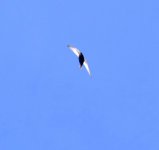KenM
Well-known member
Caught this in a shutter-burst this am. Interesting that an essentially all dark bird should at a given angle show white reflection on the almost flat under-wing surfaces and tail, and not even a glint off the barrelled body.
Presume there must be a ''physics/material'' answer to this?
Cheers
Presume there must be a ''physics/material'' answer to this?
Cheers








